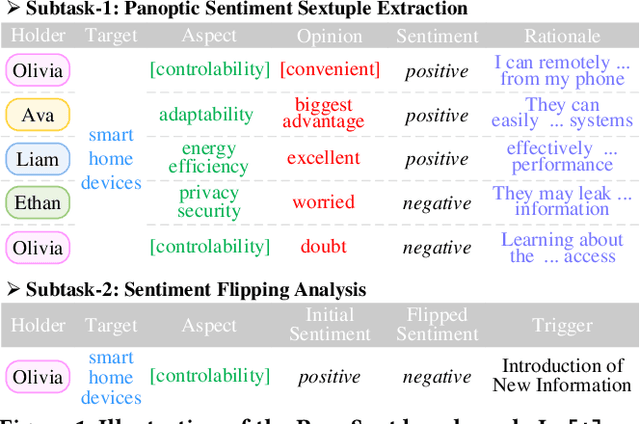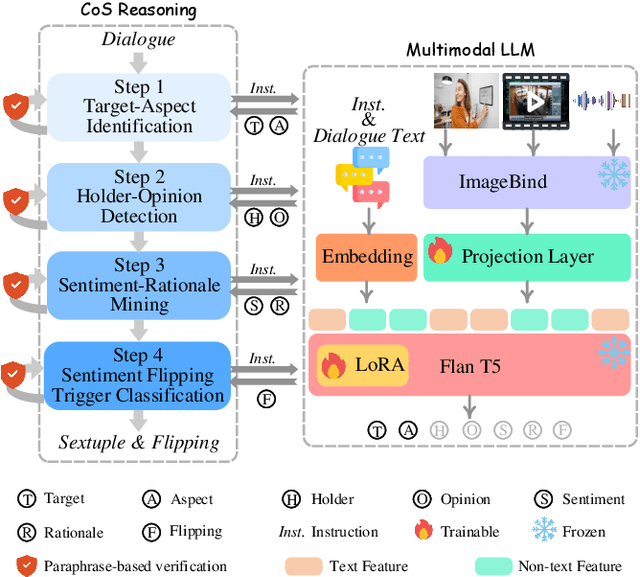Wynne Hsu
TRUST-VL: An Explainable News Assistant for General Multimodal Misinformation Detection
Sep 04, 2025Abstract:Multimodal misinformation, encompassing textual, visual, and cross-modal distortions, poses an increasing societal threat that is amplified by generative AI. Existing methods typically focus on a single type of distortion and struggle to generalize to unseen scenarios. In this work, we observe that different distortion types share common reasoning capabilities while also requiring task-specific skills. We hypothesize that joint training across distortion types facilitates knowledge sharing and enhances the model's ability to generalize. To this end, we introduce TRUST-VL, a unified and explainable vision-language model for general multimodal misinformation detection. TRUST-VL incorporates a novel Question-Aware Visual Amplifier module, designed to extract task-specific visual features. To support training, we also construct TRUST-Instruct, a large-scale instruction dataset containing 198K samples featuring structured reasoning chains aligned with human fact-checking workflows. Extensive experiments on both in-domain and zero-shot benchmarks demonstrate that TRUST-VL achieves state-of-the-art performance, while also offering strong generalization and interpretability.
On the Adaptive Psychological Persuasion of Large Language Models
Jun 07, 2025Abstract:Previous work has showcased the intriguing capabilities of Large Language Models (LLMs) in instruction-following and rhetorical fluency. However, systematic exploration of their dual capabilities to autonomously persuade and resist persuasion, particularly in contexts involving psychological rhetoric, remains unexplored. In this paper, we first evaluate four commonly adopted LLMs by tasking them to alternately act as persuaders and listeners in adversarial dialogues. Empirical results show that persuader LLMs predominantly employ repetitive strategies, leading to low success rates. Then we introduce eleven comprehensive psychological persuasion strategies, finding that explicitly instructing LLMs to adopt specific strategies such as Fluency Effect and Repetition Effect significantly improves persuasion success rates. However, no ``one-size-fits-all'' strategy proves universally effective, with performance heavily dependent on contextual counterfactuals. Motivated by these observations, we propose an adaptive framework based on direct preference optimization that trains LLMs to autonomously select optimal strategies by leveraging persuasion results from strategy-specific responses as preference pairs. Experiments on three open-source LLMs confirm that the proposed adaptive psychological persuasion method effectively enables persuader LLMs to select optimal strategies, significantly enhancing their success rates while maintaining general capabilities. Our code is available at https://github.com/KalinaEine/PsychologicalPersuasion.
Probing then Editing Response Personality of Large Language Models
Apr 14, 2025Abstract:Large Language Models (LLMs) have demonstrated promising capabilities to generate responses that exhibit consistent personality traits. Despite the major attempts to analyze personality expression through output-based evaluations, little is known about how such traits are internally encoded within LLM parameters. In this paper, we introduce a layer-wise probing framework to systematically investigate the layer-wise capability of LLMs in encoding personality for responding. We conduct probing experiments on 11 open-source LLMs over the PersonalityEdit benchmark and find that LLMs predominantly encode personality for responding in their middle and upper layers, with instruction-tuned models demonstrating a slightly clearer separation of personality traits. Furthermore, by interpreting the trained probing hyperplane as a layer-wise boundary for each personality category, we propose a layer-wise perturbation method to edit the personality expressed by LLMs during inference. Our results show that even when the prompt explicitly specifies a particular personality, our method can still successfully alter the response personality of LLMs. Interestingly, the difficulty of converting between certain personality traits varies substantially, which aligns with the representational distances in our probing experiments. Finally, we conduct a comprehensive MMLU benchmark evaluation and time overhead analysis, demonstrating that our proposed personality editing method incurs only minimal degradation in general capabilities while maintaining low training costs and acceptable inference latency. Our code is publicly available at https://github.com/universe-sky/probing-then-editing-personality.
Watch Out Your Album! On the Inadvertent Privacy Memorization in Multi-Modal Large Language Models
Mar 03, 2025Abstract:Multi-Modal Large Language Models (MLLMs) have exhibited remarkable performance on various vision-language tasks such as Visual Question Answering (VQA). Despite accumulating evidence of privacy concerns associated with task-relevant content, it remains unclear whether MLLMs inadvertently memorize private content that is entirely irrelevant to the training tasks. In this paper, we investigate how randomly generated task-irrelevant private content can become spuriously correlated with downstream objectives due to partial mini-batch training dynamics, thus causing inadvertent memorization. Concretely, we randomly generate task-irrelevant watermarks into VQA fine-tuning images at varying probabilities and propose a novel probing framework to determine whether MLLMs have inadvertently encoded such content. Our experiments reveal that MLLMs exhibit notably different training behaviors in partial mini-batch settings with task-irrelevant watermarks embedded. Furthermore, through layer-wise probing, we demonstrate that MLLMs trigger distinct representational patterns when encountering previously seen task-irrelevant knowledge, even if this knowledge does not influence their output during prompting. Our code is available at https://github.com/illusionhi/ProbingPrivacy.
Investigating the Adaptive Robustness with Knowledge Conflicts in LLM-based Multi-Agent Systems
Feb 21, 2025Abstract:Recent advances in Large Language Models (LLMs) have upgraded them from sophisticated text generators to autonomous agents capable of corporation and tool use in multi-agent systems (MASs). However, the robustness of these LLM-based MASs, especially under knowledge conflicts, remains unclear. In this paper, we design four comprehensive metrics to investigate the robustness of MASs when facing mild or task-critical knowledge conflicts. We first analyze mild knowledge conflicts introduced by heterogeneous agents and find that they do not harm system robustness but instead improve collaborative decision-making. Next, we investigate task-critical knowledge conflicts by synthesizing knowledge conflicts and embedding them into one of the agents. Our results show that these conflicts have surprisingly little to no impact on MAS robustness. Furthermore, we observe that MASs demonstrate certain self-repairing capabilities by reducing their reliance on knowledge conflicts and adopting alternative solution paths to maintain stability. Finally, we conduct ablation studies on the knowledge conflict number, agent number, and interaction rounds, finding that the self-repairing capability of MASs has intrinsic limits, and all findings hold consistently across various factors. Our code is publicly available at https://github.com/wbw625/MultiAgentRobustness.
From Personas to Talks: Revisiting the Impact of Personas on LLM-Synthesized Emotional Support Conversations
Feb 17, 2025



Abstract:The rapid advancement of Large Language Models (LLMs) has revolutionized the generation of emotional support conversations (ESC), offering scalable solutions with reduced costs and enhanced data privacy. This paper explores the role of personas in the creation of ESC by LLMs. Our research utilizes established psychological frameworks to measure and infuse persona traits into LLMs, which then generate dialogues in the emotional support scenario. We conduct extensive evaluations to understand the stability of persona traits in dialogues, examining shifts in traits post-generation and their impact on dialogue quality and strategy distribution. Experimental results reveal several notable findings: 1) LLMs can infer core persona traits, 2) subtle shifts in emotionality and extraversion occur, influencing the dialogue dynamics, and 3) the application of persona traits modifies the distribution of emotional support strategies, enhancing the relevance and empathetic quality of the responses. These findings highlight the potential of persona-driven LLMs in crafting more personalized, empathetic, and effective emotional support dialogues, which has significant implications for the future design of AI-driven emotional support systems.
Mitigating GenAI-powered Evidence Pollution for Out-of-Context Multimodal Misinformation Detection
Jan 24, 2025Abstract:While large generative artificial intelligence (GenAI) models have achieved significant success, they also raise growing concerns about online information security due to their potential misuse for generating deceptive content. Out-of-context (OOC) multimodal misinformation detection, which often retrieves Web evidence to identify the repurposing of images in false contexts, faces the issue of reasoning over GenAI-polluted evidence to derive accurate predictions. Existing works simulate GenAI-powered pollution at the claim level with stylistic rewriting to conceal linguistic cues, and ignore evidence-level pollution for such information-seeking applications. In this work, we investigate how polluted evidence affects the performance of existing OOC detectors, revealing a performance degradation of more than 9 percentage points. We propose two strategies, cross-modal evidence reranking and cross-modal claim-evidence reasoning, to address the challenges posed by polluted evidence. Extensive experiments on two benchmark datasets show that these strategies can effectively enhance the robustness of existing out-of-context detectors amidst polluted evidence.
Aristotle: Mastering Logical Reasoning with A Logic-Complete Decompose-Search-Resolve Framework
Dec 22, 2024Abstract:In the context of large language models (LLMs), current advanced reasoning methods have made impressive strides in various reasoning tasks. However, when it comes to logical reasoning tasks, major challenges remain in both efficacy and efficiency. This is rooted in the fact that these systems fail to fully leverage the inherent structure of logical tasks throughout the reasoning processes such as decomposition, search, and resolution. To address this, we propose a logic-complete reasoning framework, Aristotle, with three key components: Logical Decomposer, Logical Search Router, and Logical Resolver. In our framework, symbolic expressions and logical rules are comprehensively integrated into the entire reasoning process, significantly alleviating the bottlenecks of logical reasoning, i.e., reducing sub-task complexity, minimizing search errors, and resolving logical contradictions. The experimental results on several datasets demonstrate that Aristotle consistently outperforms state-of-the-art reasoning frameworks in both accuracy and efficiency, particularly excelling in complex logical reasoning scenarios. We will open-source all our code at https://github.com/Aiden0526/Aristotle.
ChronoFact: Timeline-based Temporal Fact Verification
Oct 19, 2024



Abstract:Automated fact verification plays an essential role in fostering trust in the digital space. Despite the growing interest, the verification of temporal facts has not received much attention in the community. Temporal fact verification brings new challenges where cues of the temporal information need to be extracted and temporal reasoning involving various temporal aspects of the text must be applied. In this work, we propose an end-to-end solution for temporal fact verification that considers the temporal information in claims to obtain relevant evidence sentences and harness the power of large language model for temporal reasoning. Recognizing that temporal facts often involve events, we model these events in the claim and evidence sentences. We curate two temporal fact datasets to learn time-sensitive representations that encapsulate not only the semantic relationships among the events, but also their chronological proximity. This allows us to retrieve the top-k relevant evidence sentences and provide the context for a large language model to perform temporal reasoning and outputs whether a claim is supported or refuted by the retrieved evidence sentences. Experiment results demonstrate that the proposed approach significantly enhances the accuracy of temporal claim verification, thereby advancing current state-of-the-art in automated fact verification.
PanoSent: A Panoptic Sextuple Extraction Benchmark for Multimodal Conversational Aspect-based Sentiment Analysis
Aug 18, 2024



Abstract:While existing Aspect-based Sentiment Analysis (ABSA) has received extensive effort and advancement, there are still gaps in defining a more holistic research target seamlessly integrating multimodality, conversation context, fine-granularity, and also covering the changing sentiment dynamics as well as cognitive causal rationales. This paper bridges the gaps by introducing a multimodal conversational ABSA, where two novel subtasks are proposed: 1) Panoptic Sentiment Sextuple Extraction, panoramically recognizing holder, target, aspect, opinion, sentiment, rationale from multi-turn multi-party multimodal dialogue. 2) Sentiment Flipping Analysis, detecting the dynamic sentiment transformation throughout the conversation with the causal reasons. To benchmark the tasks, we construct PanoSent, a dataset annotated both manually and automatically, featuring high quality, large scale, multimodality, multilingualism, multi-scenarios, and covering both implicit and explicit sentiment elements. To effectively address the tasks, we devise a novel Chain-of-Sentiment reasoning framework, together with a novel multimodal large language model (namely Sentica) and a paraphrase-based verification mechanism. Extensive evaluations demonstrate the superiority of our methods over strong baselines, validating the efficacy of all our proposed methods. The work is expected to open up a new era for the ABSA community, and thus all our codes and data are open at https://PanoSent.github.io/
 Add to Chrome
Add to Chrome Add to Firefox
Add to Firefox Add to Edge
Add to Edge